Kanban: Definition, 6 Rules, and its Benefits
Kanban is a crucial part of the Just in Time (JIT) system, which we discussed…
Sean Thobias
May 17, 2025In our earlier guide, we compared social media marketing to throwing a party:
Let’s now focus on Facebook’s role in social media marketing strategies, emphasizing how it helps you reach your audience better. We aim to provide valuable tips and tactics for making the most out of Facebook in your marketing efforts.
To succeed in Facebook marketing, grasp its structure and operations. Facebook’s algorithm rates content, including Feed posts and Reels, to deliver the most fitting content to users, factoring in demographics, interests, and viewing history.
Facebook engineers aim for user engagement, reflected in the algorithm’s profiles, pages, and content scoring. Higher engagement boosts a piece’s Facebook algorithm score, leading to more visibility, while lower engagement reduces its exposure.
Facebook ranks content in a four-step process:
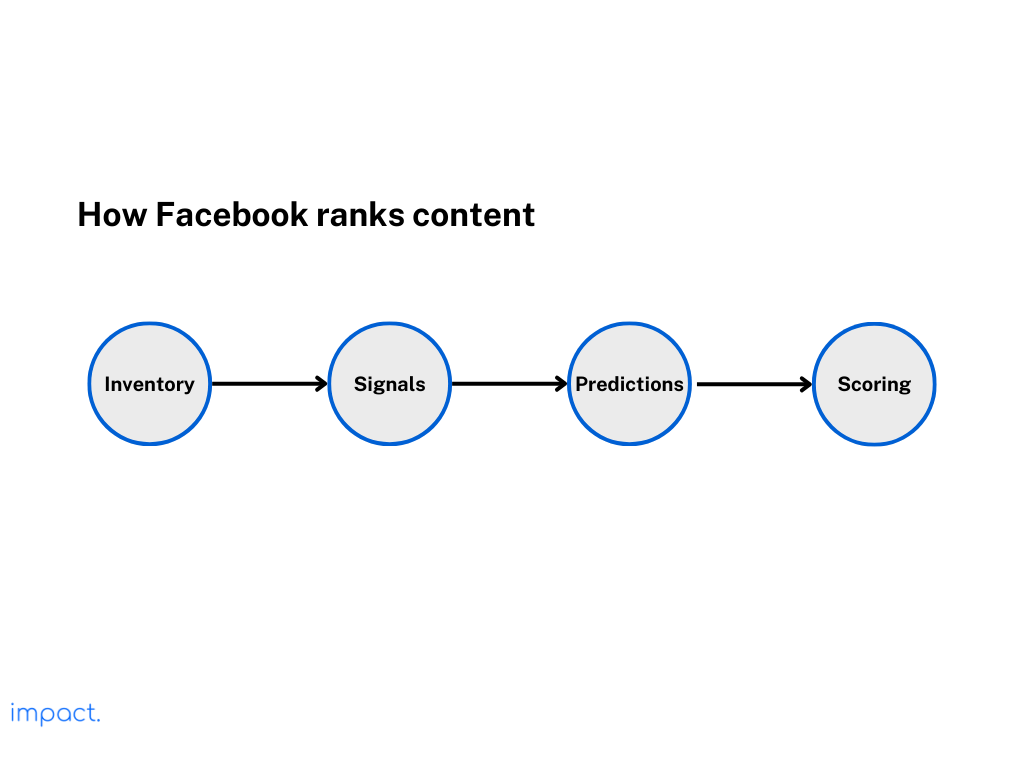
Facebook remains a major force in social media marketing, boasting three billion monthly active users as of mid-2023, making it the most significant platform worldwide. With such a vast audience, reaching new prospects, converting them into customers, and repeating the cycle becomes more straightforward.
The expansive reach of Facebook enables you to scale up campaign expenditure without concerns about reaching a limit. Implementing a well-planned strategy allows for a gradual increase in spending while maintaining cost efficiency and consistently generating leads.
Facebook advertising offers a decisive advantage: pinpoint targeting of your desired audience. With Facebook’s tools, you can zero in on specific demographics and interests, ensuring your message reaches those who matter most to your business.
Entrepreneurs can finely tune their advertising campaigns by segmenting their audience based on demographics. Facebook’s “Audience Insights” tool provides valuable data on your page visitors and followers, aiding in effective targeting.
Facebook advertising is great because it activates a brand across the entire sales funnel. Whether you want more people to know your brand, think about buying it, or buy it, Facebook ads can help.
You get different types of ads on Facebook for different marketing goals. You can use images, videos, carousels, slideshows, or dynamic ads, depending on what best shows off your product/services.
Advertising on Facebook is cheaper than TV or print ads, making it great for small and medium-sized businesses with tight budgets. With Facebook, you can reach a broader audience for almost half the price of traditional ads.
Facebook’s ad platform lets businesses control their budgets and bidding tactics, maximizing their ad spend. When done right, Facebook ads can bring in better returns and conversions than traditional advertising.
Businesses can connect directly with their audience on Facebook by sharing posts, responding to comments, and engaging in messages. This interaction builds trust and community, strengthening customer relationships.
Instead of solely relying on ad campaigns for new customers, organic marketing on Facebook ensures long-term revenue and fosters an engaged follower base. Consistency is vital — maintaining an active brand presence sets you apart from brands that neglect their Facebook pages.
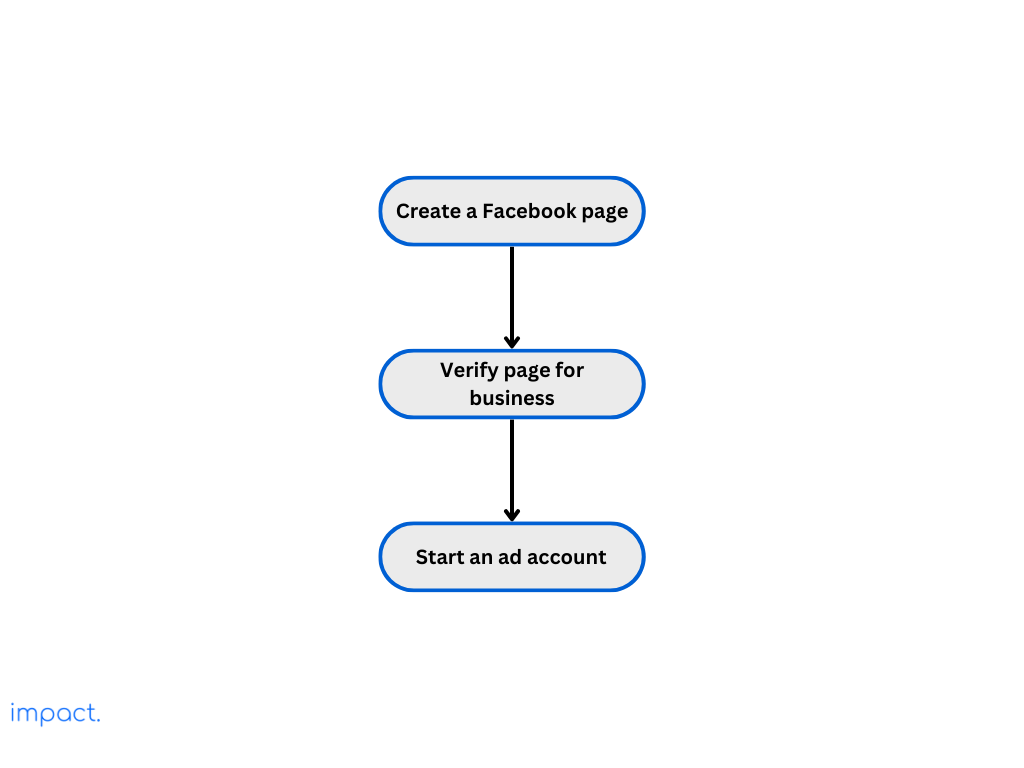
Verifying your page isn’t necessary, but it boosts your business’s credibility. To get verified:
If you want to make the most of Facebook for your business, having an ad account is essential, especially if you’re considering spending money on boosting posts or running campaigns. Here’s a simple guide to setting up your ad account for your Facebook Page:
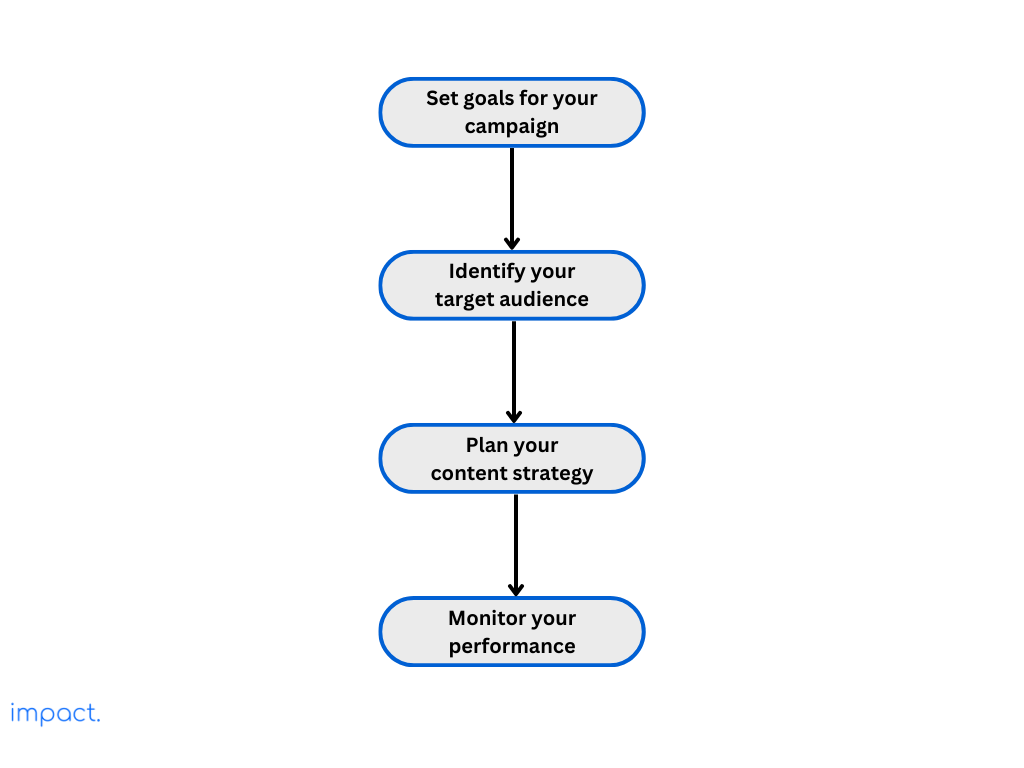
Establish clear and measurable goals before starting any marketing campaign. Ensure your goals are specific, achievable, relevant, and have a deadline (SMART).
Here are some typical Facebook campaign goals:
To find out who’s interested in your Facebook content, look at the buyer personas you’ve created for your overall marketing plan. These personas depict your ideal customers and aid in comprehending your target audience.
Facebook offers tools like Audience Insights to help you understand your audience and competitors. It gives you information on demographics and behaviors, effectively helping you tailor your content and ads.
Create a content plan that aligns with your objectives and resonates with your audience. Here’s what you should prioritize:
Monitor your campaign to ensure your Facebook ads work well and bring the most value. Utilize Facebook Ads Manager and Insights to monitor essential measures like the number of people reached, engagement levels, click-through rates (CTR), conversion rates, and return on investment from your ads.
Regularly review your campaign data to identify trends, successes, and areas for improvement. Utilize this information to adjust your target audience, messaging, visuals, and budget allocation, ensuring improved ad performance.
91% of consumers like interactive and visual content more than just reading or seeing still images. Attention-grabbing visuals are crucial to stand out, especially on social media platforms like Facebook.
Boost your posts by investing in professional photography or crafting visually engaging graphics. Clear, sharp images and videos are crucial to captivating your audience and sparking interaction.
A solid Facebook content plan is crucial to succeed online and with social media ads. Consistency is vital for reaching more people and boosting your online presence through Facebook.
Make a content calendar to organize your Facebook updates, planned content, and contests or giveaways you want to run. Posting on Facebook isn’t just about hitting “Post” — timing matters too, so think about when your audience is most active.
Facebook favors active users, so if you engage regularly with your personal and business pages, your posts are more likely to appear in your followers’ news feeds. Interacting with your audience boosts your visibility on Facebook and strengthens your relationship with your followers and customers.
Avoid using tactics solely to garner comments, tags, and likes, as Facebook now penalizes such behavior. Instead, spark discussions by asking questions and initiating debates relevant to your brand, but avoid being overly controversial.
User-generated content (UGC) makes your marketing more genuine and trustworthy. Ask your audience to share their thoughts, reviews, and pictures about your products or services.
Feature UGC on your page and organize contests to motivate your audience to create and share content about what you offer. This showcases happy customers and encourages others to connect with your brand.
Boosting your posts on Facebook can expand their reach to more people, extending beyond your current followers. Facebook ads, including boosted posts, reach over 72% of monthly active users, nearly 40% of the world’s population, considering Facebook’s 3 billion users.
The reach of your boosted post is determined by how you target and how much you spend. To maximize your reach, pinpoint which content performs well and set aside a budget to promote it to a specific audience based on age, interests, and behaviors.
Keep up with Facebook’s algorithm, features, and rules to adjust your marketing plans. Check official announcements and trustworthy sources to stay on top of updates.
Constantly adapt your strategies to make the most of new opportunities and deal with any challenges from platform changes. Keep an eye on analytics to improve your approach and stay competitive.
Excelling in Facebook marketing means you must grasp its complex algorithms and focus on creating captivating, top-notch content. Consistent effort in sharing valuable content that resonates with users is critical for boosting your presence and expanding your reach on the platform.
Moreover, integrating a solid Customer Relationship Management (CRM) system can be immensely helpful in handling customer interactions and enhancing loyalty. With CRM tools, you can monitor customer actions, tailor interactions, and foster lasting connections, which all contribute to refining your social marketing approach.
McDonald, J. (2022, July 4). Social Media Marketing Workbook: How to Use Social Media for Business.
Impact Insight Team
Impact Insights Team is a group of professionals comprising individuals with expertise and experience in various aspects of business. Together, we are committed to providing in-depth insights and valuable understanding on a variety of business-related topics & industry trends to help companies achieve their goals.
See how our software provides better value.
Speak with our consultant to explore how we can improve your accounting, processes, and people.

Companies must match their internal culture with their brand to succeed in today’s market. It’s crucial to link how a company works and how it portrays itself to establish a strong identity, attract loyal customers, and recruit the best talent.
This article, inspired by Ben Horowitz’s book “What You Do Is Who You Are,” offers a guide for businesses to connect their actions and brand identity. It emphasizes the significance of organizational culture in shaping a brand’s image.
Company culture is more than just a trendy term – it’s the living essence of your business. It encompasses all aspects that shape your company’s character, extending well beyond office perks such as casual Fridays or holiday parties.
At its peak, company culture is the invisible force that unites your team, shaping the daily narratives of your employees and playing a pivotal role in your business. The critical components of company culture include values and beliefs, behaviors and norms, and mission and vision.
These are the fundamental principles or standards that guide the decision-making and actions of individuals within the organization. Values represent what the company stands for and what is important to its success.
These are the convictions or accepted truths that individuals in the organization hold. Beliefs shape the attitudes and perspectives of employees.
People’s actions in a company are their behaviors. The company culture shapes employees’ interactions, decisions, and jobs.
Unwritten rules and expectations are called norms, like how to communicate, dress, and work hours. These norms affect the general work environment and how well everyone works together.
The mission states why the organization exists and what it aims to achieve. It outlines the core objectives and values, giving the company a clear direction.
Vision describes the organization’s future goals and aspirations to achieve long-term. It sets the strategic direction for the company, guiding its path toward success.
Read more: Start with Why and 15 Steps to Find Your Why by Simon Sinek
When a company’s culture aligns with its brand, everything it does, from actions to communication and decisions, stays consistent with its values and promises.
Consistency builds customer trust and loyalty because they can predict what to expect. It also helps the company stand out from competitors, creating a distinctive and memorable brand experience.
When a company’s culture matches its brand, it shows that it is genuine and keeps its promises. Being in sync boosts the company’s reputation, keeps customers loyal, and helps the business grow.
In a post-pandemic study by Stackla, 88% of customers say authenticity heavily impacts brand choices. So, connecting your company’s culture with its brand identity can make customers see your brand more positively.
A company’s culture should mirror its brand, making it easy for employees to understand its mission, values, and vision. This alignment creates a strong sense of purpose and belonging, boosting productivity and creating a positive workplace atmosphere.
Employees who embrace a brand’s values are more motivated to contribute to its success. Engaged workforces in companies lead to significantly higher profitability, specifically a 21% increase.
Consistent and authentic alignment between culture and branding attracts like-minded individuals who identify with the company’s values. The recruitment process can highlight the organization’s unique culture and values, making it more likely to attract candidates who are a good fit.
Additionally, employees who genuinely connect with the brand are likelier to stick around, improving retention rates. In companies with a hostile culture, 90% of employees have considered quitting, while only 32% have in those with a positive culture.

Create straightforward guidelines that clearly express your company’s culture, including its values, beliefs, and norms. These guidelines will act as a compass for all employees.
Consistently communicate these guidelines throughout the organization, from top management to new hires. Use channels like handbooks, orientation sessions, and regular updates to reinforce these principles.
Define virtues or behaviors that reflect your company’s culture based on the guidelines provided. These should shape how employees, customers, and stakeholders engage with each other.
For instance, if prioritizing customers is critical, focus on fostering empathy among staff. Encourage employees to practice these virtues regularly and acknowledge and incentivize actions demonstrating them.
Your employees play a vital role in shaping your company’s culture and branding. Encourage them to represent your culture inside and outside the organization by giving them the tools, resources, and training they need to understand and embrace your company’s values.
Using employee stories and testimonials in your branding makes your company more relatable and strengthens its bond with customers. Also, involve employees in decision-making and ask for their input on culture and branding matters.
Culture changes, and so should your branding. Ensure your branding keeps up with shifts in your company culture and the wider business environment.
Ask for employee, customer, and stakeholder feedback to see if your branding matches your culture and connects with your audience. Keep refining your branding strategies to stay faithful, current, and impactful in communicating your company’s culture.
Maintaining a consistent brand culture across different platforms and throughout time is challenging but vital. Every aspect of a business should consistently reflect the brand’s culture.
ERP software can help keep brand culture consistent as they are flexible, allowing organizations to adjust them to fit their unique cultural needs. With customizable interfaces, workflows, and terminology, companies can ensure their brand’s culture is embedded in every aspect of their operations.
Preserving a company’s culture as it grows can be challenging. Rapid expansion and changes can water down the values that initially made the brand unique.
To address this, develop scalable strategies that can evolve with the company. Invest in comprehensive onboarding and training, establish clear cultural guidelines for new hires, and empower employees to embody the company’s values.
Employees might see the company one way, while customers see it differently. This difference can make the brand seem less genuine and reliable.
To fix this, encourage open communication among employees and make sure they understand the company’s culture. Also, talk to customers to see how they view the brand and adjust as needed to match internal and external perspectives.
It’s essential for leaders to fully understand the significance of integrating culture into branding to overcome hurdles. Without their commitment, efforts to establish a cohesive organizational culture may fail, leaving employees feeling disconnected.
Leaders must set an example, invest in initiatives, hold themselves and others accountable, and be adaptable. Strong leadership is crucial to a culture that reinforces the brand, engages employees, and secures long-term success.
Your company’s culture shines through in every brand interaction with customers. Integrating culture into branding is essential for building a unique and genuine brand identity that stands out from competitors.
One effective way to maintain consistency is by using tools like ERP software. By setting up the ERP system to reflect your organization’s values, you can embed those values into all aspects of operations, from finance and HR to supply chain and customer management.
Horowitz, B. (2019). What you do is who you are: How to Create Your Business Culture. HarperBusiness.
Impact Insight Team
Impact Insights Team is a group of professionals comprising individuals with expertise and experience in various aspects of business. Together, we are committed to providing in-depth insights and valuable understanding on a variety of business-related topics & industry trends to help companies achieve their goals.
See how our software provides better value.
Speak with our consultant to explore how we can improve your accounting, processes, and people.

Word of mouth heavily influences 20-50% of purchasing decisions, but surprisingly, only about 7% of it occurs online, as per research by the Keller Fay Group.
To make things popular, you need virality. This article breaks down the concept and guides you on achieving virality using Jonah Berger’s six key elements (STEPPS) from his book “Contagious – Why Things Catch On“: Social Currency, Triggers, Emotion, Public, Practical Value, and Stories.
Virality is how fast and far something, like a message or content, spreads among people, often through word of mouth, social media, or online platforms. When something goes viral, it grabs much attention, and many people share it fast.
Knowing virality is crucial for marketers, content creators, and anyone aiming to reach a big audience with their message or product. Yet, predicting what will go viral is challenging since it hinges on unpredictable factors.
Creating viral content means your ideas get shared without spending much on ads. It usually spreads through social media, word of mouth, and online platforms.
Viral content often prompts user-generated content, which about 85% of consumers find more influential than brand visuals. You can save money on marketing by gaining visibility and organic following without paid promotions.
Creating viral content can quickly connect with a vast audience. When your audience shares this content, it expands beyond your initial target, helping you reach new markets and demographics not easily reached through traditional marketing.
This extensive reach is crucial for boosting brand exposure and increasing sales. Simplifying the sharing process, such as adding social media buttons or providing easy-to-copy links on your website, encourages more people to spread your message.
Viral content grabs much attention, boosting how well people know your brand. People sharing and interacting with your content get to know your brand and its offerings.
More exposure helps people remember your products or services when deciding what to buy. Going viral also builds a positive image for your brand, making your business stand out as trustworthy and well-known.
When content goes viral, it brings people who share an interest in or connection to the brand. Virality sparks conversations and interactions on social media and in person, fostering customer loyalty and a sense of community.
Active involvement leads to a more dedicated customer base. In fact, 73% of companies rely more on existing customers than exploring new markets.
The more your content goes viral, the more it shows potential customers that your brand is worth noticing. When people see others sharing and interacting with your content, it builds credibility and authenticity.
This social proof boosts consumer trust and buying choices. A better brand reputation can attract customers to choose your products/services over competitors.
Jonah Berger discovered six fundamental principles that often make messages, products, and ideas spread widely. These are the STEPPS principles:
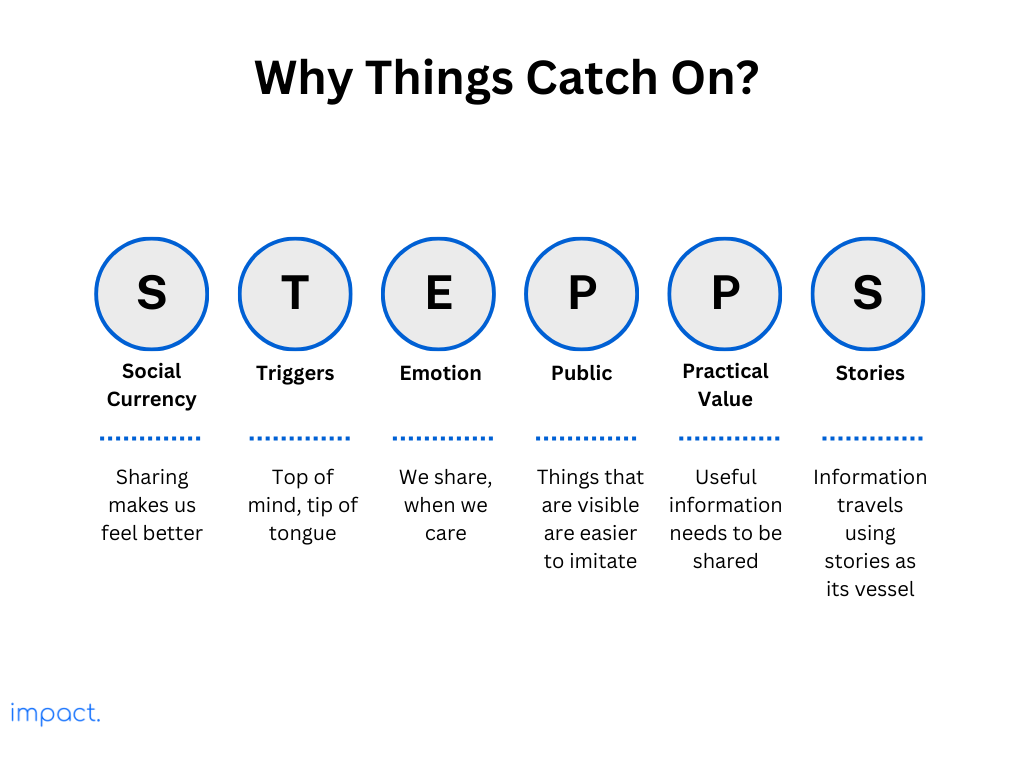
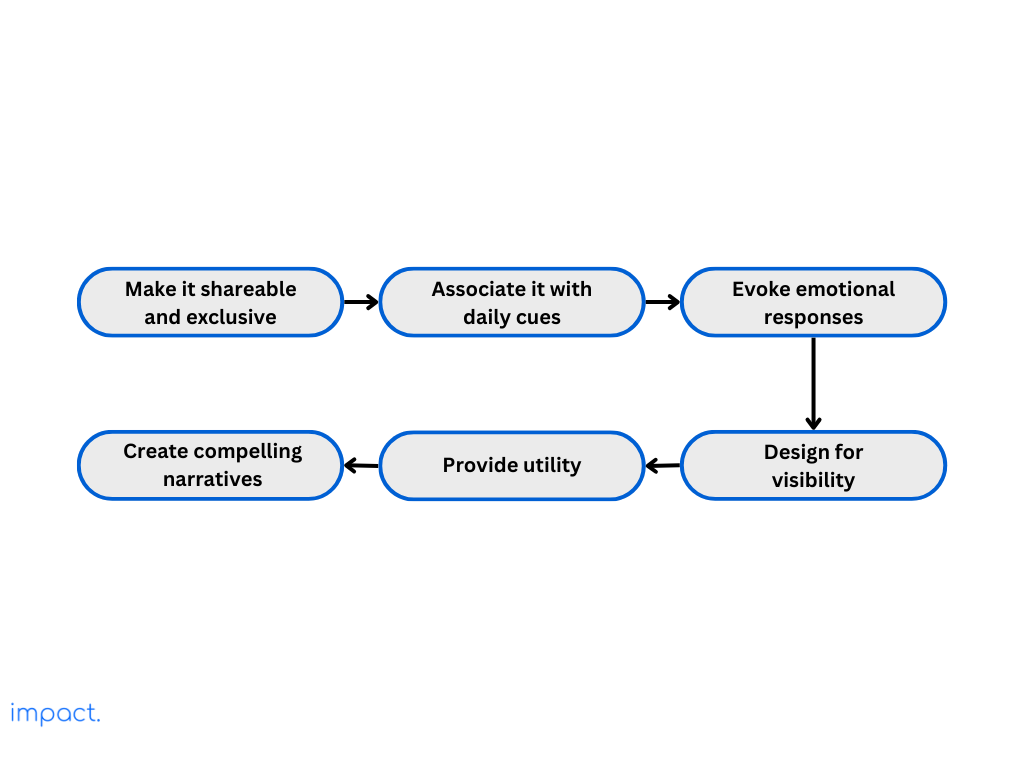
Create shareable and exclusive content to boost your brand’s virality. Introduce limited-time promotions or exclusive sneak peeks to create urgency and motivate users to share for exclusivity.
Leverage social media and offer incentives like discounts or special access to amplify content sharing. Find the sweet spot between shareability and exclusivity to ensure your content spreads while maintaining a coveted user experience.
To seamlessly integrate your brand into your audience’s daily life, align your content with their habits and interests. Identify their regular activities and craft content that effortlessly blends into their routines.
Enhance your brand’s connection by producing timely, relevant content that ties your messages to current discussions or events. This integration into your audience’s daily routine strengthens the bond with them
Intense emotions, whether good or bad, push people to take action. While positive news tends to be shared more, articles that make readers angry or anxious get passed around.
Understand what emotions resonate with your audience and adjust your content strategy accordingly. Creating emotional ties helps your brand stick in people’s minds, encouraging them to share their emotional stories with others.
Since most people process 90% of information visually and 65% are visual learners, the appearance of your content is essential for grabbing attention and making it go viral.
Create content that looks great, is easy to understand, and can be shared on different platforms. Use your brand’s imagery consistently to build a recognizable look that engages with people wherever they are.
Create content that solves problems, fulfills needs, or shares valuable information. Whether it’s guides, videos, or tips, valuable content establishes your brand as an authority.
Know your audience’s problems and challenges to tailor your content for them. Consistently providing value makes your brand a go-to resource, building loyalty and prompting users to share positive experiences.
Create captivating stories to grab your audience’s attention and make your brand go viral. Develop a narrative that ties together your brand’s history, customer experiences, or related content pieces.
Make your content share-worthy by creating episodic stories that keep users returning for more. Encourage user engagement with interactive elements or content that invites them to be part of the narrative.
Conduct in-depth research to discover your audience’s preferences, behaviors, and preferred communication channels. Understand what appeals to them, identify their pain points, and recognize valuable content.
Failure to comprehend your audience may lead to a misalignment between your brand message and your audience’s values. Ensure your content resonates with your audience to avoid this mismatch and effectively communicate your brand message.
Consistency in your brand is vital for trust and recognition, with Lucidpress stating it can boost revenue by 10-20%. This involves keeping visual elements, tone, and messaging consistent across all platforms.
A consistent brand builds a clear and memorable identity, helping your audience easily recognize and share your content. Conversely, inconsistency can erode trust and impede your brand’s viral potential.
Authenticity matters to 88% of consumers when choosing brands. People are more likely to share content that feels real and relatable.
Avoid deceptive tactics like exaggerating product benefits or pretending to support a cause without genuine commitment. Inauthenticity can harm a brand’s credibility, leading to negative reviews, decreased loyalty, and reduced chances of virality.
Diversify your content strategy to reach more people. Use a mix of images, videos, blogs, and interactive content because everyone likes different things.
Experiment with various topics and styles to find what your audience likes best. If you don’t vary the content, your audience may lose interest, resulting in less sharing.
Regularly check how well your content is doing by looking at engagement, shares, and conversions. Learn from what works and improve your strategy for creating content that gets shared more.
Consider using software like an ERP that centralizes data from different departments; this can be incredibly useful for marketing teams to analyze customer behavior, track trends, and find opportunities for brand promotion.
Stay updated with trends and include them in your content strategy to keep your brand visible and relatable. Watch for industry trends, popular hashtags, and cultural happenings for timely and relevant content opportunities.
Ignoring trends can make your brand seem outdated, reducing your content’s shareability and viral potential. Stay relevant to avoid appearing out of touch with your audience.
In 2015, Apple’s ‘Shot on iPhone’ campaign showcased the superior camera quality, creating a buzz on social media and sparking a content creation trend. The campaign’s success, fueled by memes, positioned Apple as the top choice for camera enthusiasts, highlighting its innovative approach to brand presence and product quality.
Here’s an analysis of its virality using the STEPPS principles:
The ALS Ice Bucket Challenge became a worldwide viral sensation to boost awareness and funds for ALS research. Celebrities like Bill Gates and Oprah Winfrey joined in, pouring ice water on themselves and raising over $220 million, with a lasting 25% increase in contributions even after the campaign concluded.
Here’s an analysis of its virality using the STEPPS principles:
The STEPPS framework is a thorough guide for grasping and utilizing the components that drive the contagious spread of ideas. Yet, predicting virality proves challenging due to numerous unpredictable factors.
Although software like ERP systems and CRM can provide valuable insights by centralizing data, it’s crucial to understand that the core of virality is authenticity. Trying to force content to go viral might bring short-term gains, but a lasting and organic message spread requires a genuine connection with the audience.
Berger, J. (2016). Contagious: Why Things Catch On. Simon and Schuster.
Impact Insight Team
Impact Insights Team is a group of professionals comprising individuals with expertise and experience in various aspects of business. Together, we are committed to providing in-depth insights and valuable understanding on a variety of business-related topics & industry trends to help companies achieve their goals.
See how our software provides better value.
Speak with our consultant to explore how we can improve your accounting, processes, and people.

Traditional branding uses old marketing methods to build a strong brand image by highlighting company values, mission, and unique selling points. However, here’s the truth: customers are more interested in their stories than yours.
Create a strong brand using Donald Miller’s StoryBrand Framework by putting your customers at the center. Develop a buyer persona to connect emotionally with your target audience, uncover their needs, and effectively communicate why your product or service is meaningful to them.
The StoryBrand Framework is all about storytelling and how it naturally captivates people. According to Donald Miller, businesses should guide the customer’s story, with the customer as the hero. The framework has seven key elements:
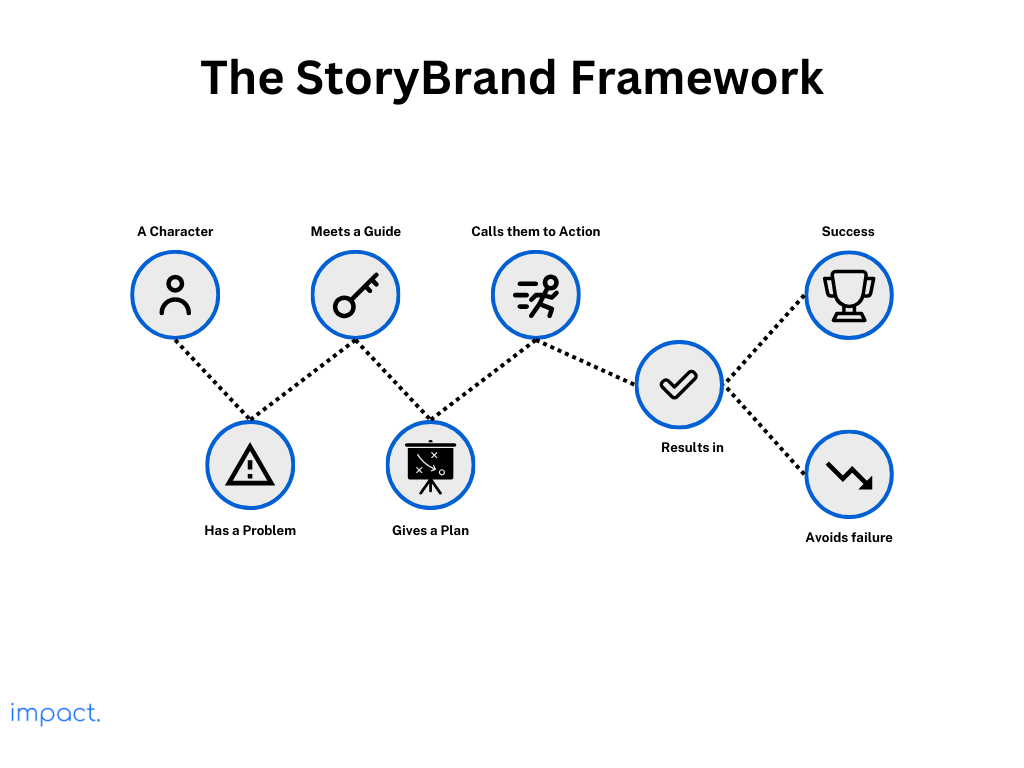
The StoryBrand Framework aims to create a clear and compelling narrative that resonates with customers, making it easy for them to understand the value and take action. Businesses can improve communication and marketing effectiveness by simplifying the message and focusing on the customer’s journey.
A buyer persona is like a detailed profile of your perfect customer, created from actual data and market research. It shows background, behavior, preferences, pain points, and more, helping businesses target and understand their audience in marketing and sales.
Here are some standard components found in a buyer persona:
This part closely examines the buyer’s personal and professional details, like their job title, industry, company size, and location. Knowing their background helps customize marketing and products to match the buyer’s needs.
Identifiers are characteristics that help us identify a buyer quickly. There are three types:
Pain points are the issues and frustrations buyers face. Recognizing these challenges is essential for creating effective marketing messages and product solutions.
This understanding enables you to empathize with customers, highlight the value of your offerings, and position your brand as a problem solver. You can address these pain points directly and develop targeted solutions that meet the buyer’s needs.
Buyer personas give detailed information about your customers, what they do, and what they like. With this knowledge, you can create an effective marketing strategy that connects with your audience’s needs and preferences.
Recognizing and remembering your customers pays off. According to Accenture, 91% of consumers are more inclined to buy from brands that offer relevant offers and recommendations.
Companies often confuse customers by using different visuals and messages across platforms. Confusion can lead to missed opportunities for gaining new customers and growth and reduced loyalty.
Craft a brand message that directly addresses the concerns and aspirations of your target audience by using a buyer persona. It ensures your brand communication is relatable, emotionally appealing, and relevant.
Consistent branding is vital for business success. It boosts revenue growth for two-thirds of companies, with those maintaining consistency being 3.5 times more visible than those with an inconsistent brand.
Using a buyer persona helps unify your brand across different marketing channels. It ensures that your messaging, visuals, and tone align seamlessly, creating a solid and cohesive brand identity for your diverse audience.
Creating buyer personas is crucial for intelligent marketing. It helps you use your marketing budget wisely by concentrating on the customers that matter most.
Doing this saves time and effort, ensures your messages hit the right people, and boosts your marketing return on investment.
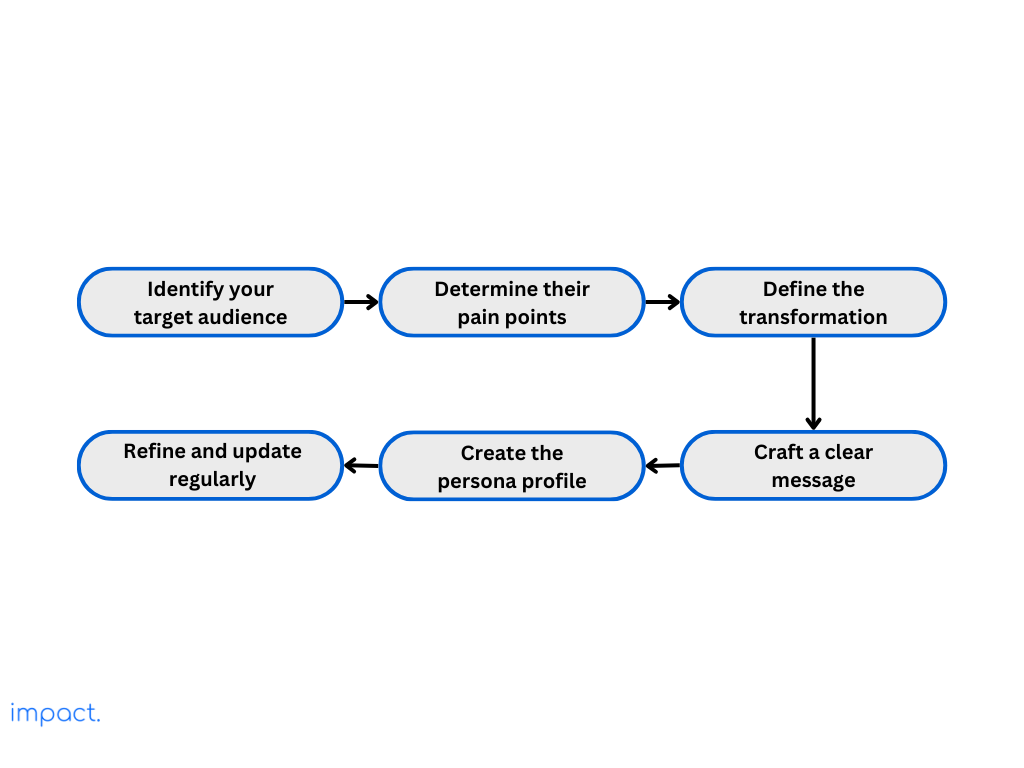
In the StoryBrand Framework, customers are the heroes of their own stories. To create a buyer persona, identify your target audience by understanding their demographics, psychographics, and behaviors.
For detailed insights, conduct market research and surveys and analyze customer data to gather relevant information.
Identify your customer’s exact problem – what they struggle with daily. Pain points are critical because it lays the groundwork for your brand to offer a solution.
Highlight the specific challenges and annoyances your target customer goes through, building a relatable link between them and your brand.
Outline how your product makes a positive impact on people’s lives. Envision the change they’ll go through — from their current situation to their desired state.
This transformation is at the heart of your product’s delivery, aligning with the StoryBrand Framework.
Craft a clear and engaging message showcasing how your product or service directly solves customer’s pain points, resulting in a positive transformation. Whether making a purchase, trying a trial, or reaching out, use persuasive language to prompt the customer to take that next step.
Keep it simple, skip the jargon, and keep the focus on the customer. Highlight the benefits explicitly and guide them through the process for a seamless experience.
Create detailed and realistic buyer personas by using the gathered information. Each persona should represent a specific group in your target audience.
Give your persona a name and a face (using stock photos), and include details about demographics, challenges, preferences, and buying behavior. This step humanizes your audience, making it easier for your team to relate to and understand your customers.
Keep your messaging in sync with your customer’s changing needs as the market evolves. Regularly update your personas to reflect your target audience’s ongoing journey and challenges.
Stay on top of industry trends, customer feedback, and market shifts that could affect your audience. This constant refinement ensures that your marketing and branding efforts stay relevant and effective.
Meet Alex Johnson, a 38-year-old entrepreneur who owns the small digital marketing agency “PixelCrafters.” With over a decade of experience in marketing, Alex ventured into entrepreneurship three years ago, offering tailored digital marketing solutions for small and medium-sized businesses aiming to enhance their online visibility.
Your product/service is a comprehensive digital marketing toolkit for small businesses like PixelCrafters. It offers:
Insufficient data can impede the development of precise buyer personas, leading to broad assumptions. Conduct comprehensive market research, surveys, and data analysis to remedy this.
Utilize customer feedback, analytics, and social media insights, and explore tools like ERP software to efficiently collect and organize data from various departments like sales, marketing, and customer service, providing a unified view of customer interactions and preferences.
Marketers often make a big mistake by relying on assumptions when creating buyer personas. Simply collecting anecdotes from your customer-facing team isn’t sufficient.
Without proper validation, these assumptions can result in inaccurate personas that don’t reflect your target audience’s behaviors and preferences. To avoid this, continually validate and refine your buyer personas using real-world customer interactions, sales data, and market feedback. Make adjustments based on actual results and performance metrics.
Negative buyer personas are profiles that tell you which people are unlikely to become customers. They’re the ones who don’t fit well with your company.
Create these negative personas to weed out leads that probably won’t become customers. It makes your marketing more focused, reaching only those likely to find value in your offer.
Don’t just focus on demographic information; it won’t make your personas stand out. You might miss essential psychographic and behavioral factors if you only consider demographics.
Think about your persona’s daily activities, media consumption, challenges, and how they measure success. Base your personas on this information to guide when and how you interact with your audience.
Having 4-5 personas is excellent, but having too many can harm your marketing. Personas are about representing different customers and enhancing their experiences based on who they are, what they value, and how they prefer to do business with you.
Group similar segments and prioritize personas based on their impact on your business goals and market potential. Quality matters more than quantity, so focus on the most impactful personas to optimize your marketing strategy.
Many businesses mistakenly think that creating personas is only for marketing. The problem arises when marketing, sales, and customer support don’t collaborate, leading to misaligned buyer personas.
To fix this, apply the persona throughout your entire funnel strategy and ensure everyone in the organization knows who they are dealing with. Foster communication and collaboration between departments to ensure consistent and comprehensive information from various sources.
Businesses build genuine connections by recognizing that customers are more interested in their stories than corporate talk. When you incorporate buyer personas into your marketing, it’s not just a strategy — it’s a dedication to truly understanding and connecting with your target audience.
Crafting a solid buyer persona requires collecting and organizing customer data through research. Using ERP software streamlines this process, automating your efforts for efficiency.
Miller, D. (2017). Building a Storybrand: Clarify Your Message So Customers Will Listen. HarperCollins Leadership.
Impact Insight Team
Impact Insights Team is a group of professionals comprising individuals with expertise and experience in various aspects of business. Together, we are committed to providing in-depth insights and valuable understanding on a variety of business-related topics & industry trends to help companies achieve their goals.
See how our software provides better value.
Speak with our consultant to explore how we can improve your accounting, processes, and people.

Today, we’ve shifted from mass production to mass customization, and our choices have multiplied, making us information-rich but time-poor. As a result, the old method of comparing features and benefits no longer suffices.
When a brand is well-known and has a positive image, people are more likely to trust it. However, building a strong brand is not an easy task. Using Marty Neumeier’s five branding disciplines from his book, “The Brand Gap,” this article aims to help you create a successful brand by understanding what a brand is and how to brand your product correctly.
According to Neumeier, a brand isn’t just a logo or product; it’s how someone feels about a product, service, or company. This feeling is rooted in our emotions and intuition, shaped by individuals rather than companies, markets, or the general public.
Businesses can’t completely control this process; they can only shape it by highlighting what makes their brand special. A brand is like a common idea in society – for example when we think of smartphones, we usually link brands like Apple or Samsung with that type of product.
Brand strategies often fall into two camps: analytical marketers and emotional creatives. This divide, known as the brand gap, is the distance between a company’s brand strategy and creativity.
Bridging this gap results in a charismatic brand, where communication is clear and powerful, quickly reaching people without distortion or confusion. Such brands, highly valued by consumers, often lead their categories with significant market shares and the ability to charge premium prices, making them less likely to be seen as generic products.
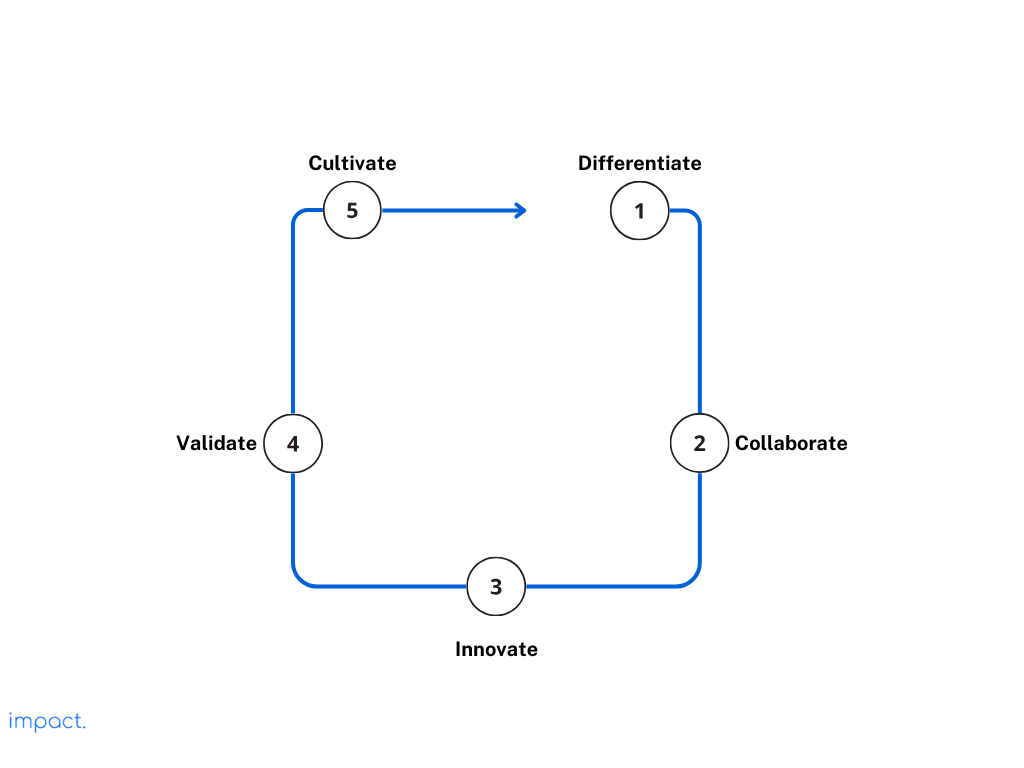
When building your brand, ask three key questions:
Our brains naturally pay attention to variations in what we see, whether big or small, like light and dark, rough and smooth, or stillness and motion, to make sense of things. Being unique helps your brand grab attention and stand out in information overload.
Modern marketing builds a tribe, shifting focus from product attributes to user experience and personal identity. While features and benefits matter, your sense of self precedes today’s marketing landscape.
Brands don’t just appear on their own; they come from the efforts of many people over a long time. Building a brand involves executives, marketers, and experts like strategy consultants, designers, advertisers, researchers, PR professionals, and more.
Here are three basic models for brand collaboration:
One firm handles most communication. It’s convenient because it keeps the message consistent and makes management more accessible for the client.
However, the downside is that the different services may not be the best, and the company gives control of the brand to one firm.
This model is like a one-stop shop. The agency takes charge of the project and can also act as a contractor, with other firms serving as subcontractors.
This approach has benefits like delivering a consistent message across various media and the flexibility to collaborate with top-notch specialists. However, a downside is that the brand agency holds more control over the brand than the client company.
Branding is an ongoing effort that a company should manage internally. The company engages directly with them instead of relying on various niche agencies or freelancers.
This approach offers benefits such as maintaining a consistent message across different media, the flexibility to collaborate with specialists, and having internal control over brand knowledge. However, a downside is the need for a robust internal team to operate an integrated marketing approach effectively.
Read more: Retail Advertising: 6 Simple Steps and its Best Practices
Many ads fail to connect emotionally with readers today, and the issue lies not in brand strategy but in execution — specifically, creativity. Creativity is the elusive element in the branding mix, often described as magic rather than logic, igniting passion in customers.
Creativity isn’t about starting from scratch but approaching things with a fresh perspective. Successful creative thinkers often opt for the “MAYA” principle – choosing the Most Advanced Yet Acceptable option.
Here are ways to be more innovative in your branding:
Embrace innovation fearlessly by choosing the MAYA option for ongoing progress. Innovative ideas may seem risky or unconventional, challenging the status quo, and might initially feel unsettling.
Disruption is part of the package, introducing new ways of thinking or doing things. Don’t be afraid — true innovation often demands stepping out of comfort zones and embracing uncertainty.
Customers always look for easy ways to recognize, remember, discuss, and compare brands. A brand’s most valuable asset is often its name, playing a crucial role in standing out and gaining acceptance.
When creating a brand name, keep these seven criteria in mind for success:
A brand icon is the name and symbol that show where a brand stands in the market. An avatar icon acts like the brand’s alter ego, able to move or change.
In today’s digital world, branding is more than just putting a logo on things. It’s about keeping up a conversation between the company and its audience across different platforms. Icons and avatars adapt to this by stepping out of traditional print and engaging with people wherever they are.
According to a study by POPAI (Point of Buy Advertising International), 76% of purchasing decisions happen in-store. When competing products surround customers, their initial preferences and memories of past ads take a back seat as products vie for their attention.
Customers follow a specific order when processing messages based on the product, and messages presented out of order are often ignored. The usual sequence is as follows:
Adequate packaging relies on clear communication, evoking emotions, and maintaining a natural flow when presenting information — principles that are universally applicable to all forms of brand design.
Communication in the olden days was like a one-way street – sender, message, receiver. However, it’s outdated because real communication goes both ways; you need to know how your customers respond.
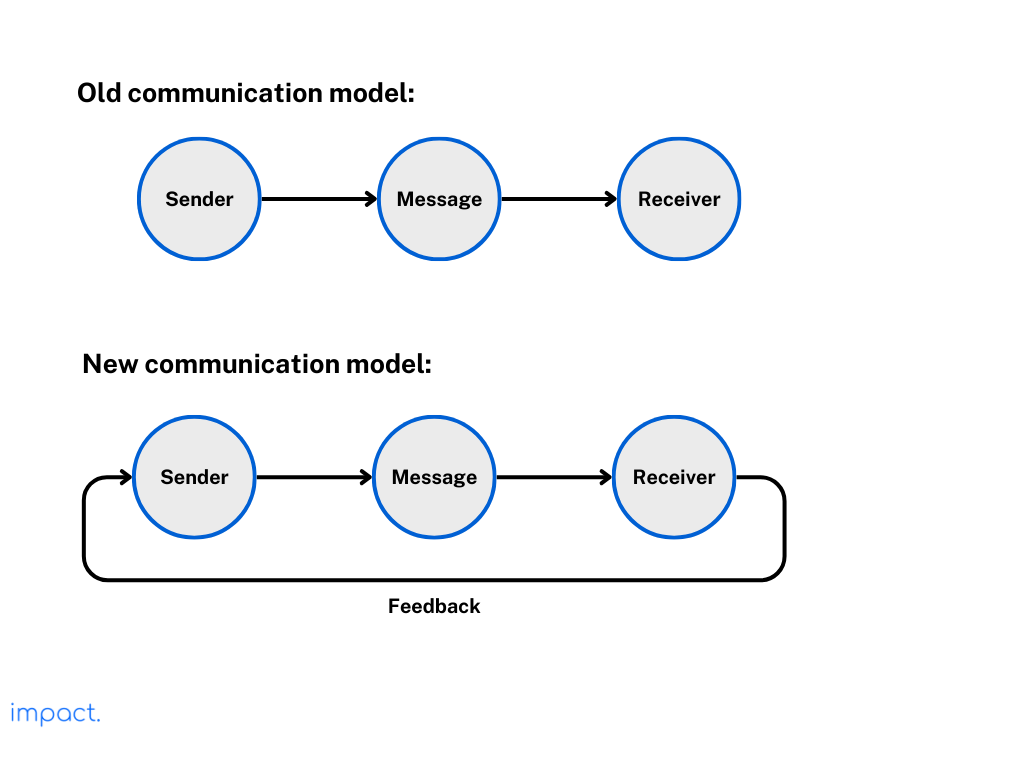
Transform the monologue into a dialogue by adding a crucial step: feedback. Each round in the feedback loop strengthens and sharpens communication.
Gain feedback on your creative ideas before launching them with these tests:
Try replacing a part of your icon, like your name or a picture, with something from a competitor.
If theirs looks better or just as good, you can improve. If theirs looks worse than yours, then you’re good as you are.
Try the hand test as a variation of the swap test to quickly assess the impact of ads, brochures, and web pages. Cover the icon in your marketing material and see if you can identify the creator.
If you can’t, your communication lacks strength; it should distinctly represent your brand, allowing people to recognize it by its voice, look, and feel.
A simple concept test makes developing names, symbols, icons, taglines, and brand promises easier. It focuses on two key things: getting the right idea and getting it right.
To test your concept, make prototypes of the brand element and show them to at least ten people who are not company insiders. Ask them questions like:
For the best feedback, test prototypes in real situations. If your prototype is supposed to be in a shop, test it there. If a product is intended for packaging, test it next to similar items in packaging.
When conducting on-field tests, focus on five critical elements of brand expression:
Read more: Unlocking Growth: 19 Traction Channels for Business Success
Thriving businesses stay successful by staying flexible and evolving with market, industry, economic, and cultural shifts. Instead of sticking to rigid structures, they act more like living entities, adjusting, growing, dividing, and combining as required.
In contrast to the traditional corporate focus on uniformity and consistency, the modern approach to branding values vitality and dynamism over strict adherence to sameness.
A Lucidpress study reveals that keeping your brand consistent on all platforms can boost revenue by up to 23%. Maintaining a uniform brand image, message, and voice enhances recognition, helping your brand stand out in the competitive marketplace.
Think of your brand like a person: you can change its appearance, not its core traits. Instead of focusing on controlling the visual aspect, embrace a new approach that influences the character of your brand. This approach guarantees consistency in the eyes of your customers, aligning behavior with the overall brand image.
Once you’ve sorted out the details, worked together, come up with new ideas, and confirmed everything, it’s time for each employee to get their own sturdy set of thoughts about what the brand is and how it works.
Branding is something you can learn, teach, copy, and nurture. Ongoing education programs help align everyone in the company, while seminars, workshops, and critiques ensure that outside partners stay in harmony.
As your brand grows, it becomes more vulnerable. A failed launch, unclear brand focus, or any hint of scandal can harm credibility and lower brand value. In today’s globalized world, bad news spreads quickly and widely.
Constantly renew corporate memory for long-term brand success. Implement a brand education program, involve the creative network, and consider a Chief Brand Officer (CBO) to bridge logic and magic, strengthening the brand connection.
Solving the brand gap means finding the right balance between brand strategy and creativity for businesses. The five branding disciplines discussed here form a virtuous circle, boosting your brand value and leading to a sustainable competitive advantage.
Integrating software with customer relationship management (CRM) capabilities can simplify your brand-building process. These tools centralize your customer data, ensuring a consistent brand image and enabling agile strategy adjustments for a strong market presence.
Neumeier, M. (2006b) The Brand Gap: How to Bridge the Distance Between Business Strategy and Design : a Whiteboard Overview. Peachpit Press.
Impact Insight Team
Impact Insights Team is a group of professionals comprising individuals with expertise and experience in various aspects of business. Together, we are committed to providing in-depth insights and valuable understanding on a variety of business-related topics & industry trends to help companies achieve their goals.
See how our software provides better value.
Speak with our consultant to explore how we can improve your accounting, processes, and people.
